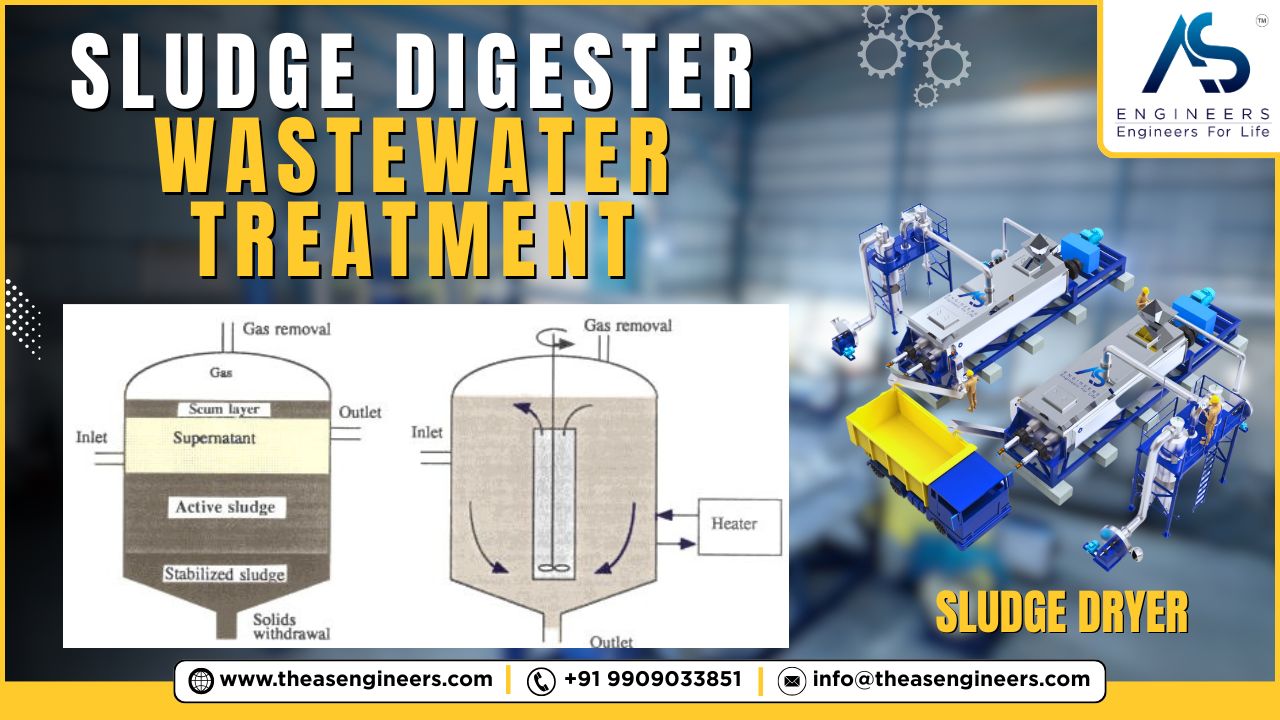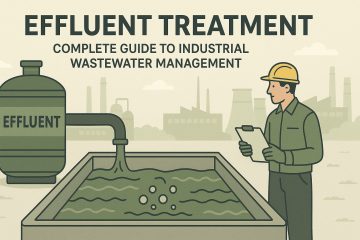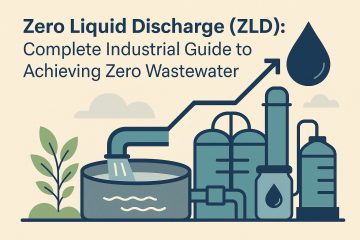Wastewater treatment plants process over 34 billion gallons of sewage daily across the United States, generating millions of tons of biosolids that require proper management. Sludge digester wastewater treatment plants represent the most critical phase in transforming hazardous waste into valuable resources while protecting public health and the environment. This comprehensive guide reveals how modern sludge digesters revolutionize waste processing, reduce operational costs by up to 40%, and convert organic waste into renewable energy sources.
Understanding sludge digester systems empowers facility managers, environmental engineers, and municipal planners to optimize treatment processes, achieve regulatory compliance, and maximize resource recovery from wastewater operations.
Table of contents
- What Is Sludge Digester Wastewater Treatment?
- Types of Sludge Digesters in Wastewater Treatment
- The Sludge Digestion Process Explained
- Benefits of Sludge Digester Wastewater Treatment
- Design Considerations for Optimal Performance
- Common Challenges and Solutions
- Future Trends in Sludge Digester Technology
- Frequently Asked Questions
- Conclusion
What Is Sludge Digester Wastewater Treatment?
Sludge digester wastewater treatment involves the biological decomposition of organic matter in raw sludge and sewage sludge through controlled anaerobic or aerobic processes. These specialized reactor systems break down complex organic compounds, reduce pathogenic microorganisms, and stabilize waste materials for safe disposal or beneficial reuse.
Primary sludge from settling tanks contains 95-97% water content and high concentrations of organic solids. Secondary sludge from biological treatment processes adds activated microorganisms and additional organic matter. According to the U.S. Environmental Protection Agency, sludge digesters process these combined waste streams through carefully controlled biological reactions that occur in sealed vessels over extended retention periods.
The digestion process transforms putrescible organic matter into stable end products while generating valuable byproducts including biogas for energy production and nutrient-rich biosolids for agricultural applications.
Types of Sludge Digesters in Wastewater Treatment
Anaerobic Digesters
Anaerobic sludge digesters operate without oxygen, creating ideal conditions for methane-producing bacteria to break down the content of sludge organic compounds. These systems typically maintain temperatures between 95-100°F (mesophilic) or 130-135°F (thermophilic) with retention times ranging from 15-30 days.
Key advantages include:
- High methane production for energy recovery
- Significant volume reduction (50-60%)
- Lower operating costs due to minimal aeration requirements
- Effective pathogen destruction through extended processing
Design considerations:
- Requires precise pH control (6.8-7.2 range)
- Sensitive to toxic substances and temperature fluctuations
- Higher capital investment for heating and gas collection systems
- Regular monitoring of volatile fatty acids and alkalinity levels
Aerobic Digesters
Aerobic sludge digesters utilize oxygen-rich environments where aerobic digestion by aerobic bacteria consumes organic matter through oxidation processes. These systems operate at ambient temperatures with shorter retention times of 10-20 days but require continuous aeration.
Primary benefits:
- Simpler operation and maintenance procedures
- Lower capital costs for smaller facilities
- Stable operation with minimal process upsets
- Effective odor control through complete oxidation
Operational requirements:
- Continuous air supply increases energy consumption
- Produces less energy recovery compared to anaerobic systems
- Requires larger reactor volumes due to lower processing efficiency
- Higher sludge production requiring additional handling
Hybrid Systems
Advanced facilities increasingly deploy hybrid sludge digester configurations combining anaerobic and aerobic processes to optimize treatment efficiency and resource recovery. These integrated systems maximize methane production while ensuring complete stabilization and pathogen reduction.
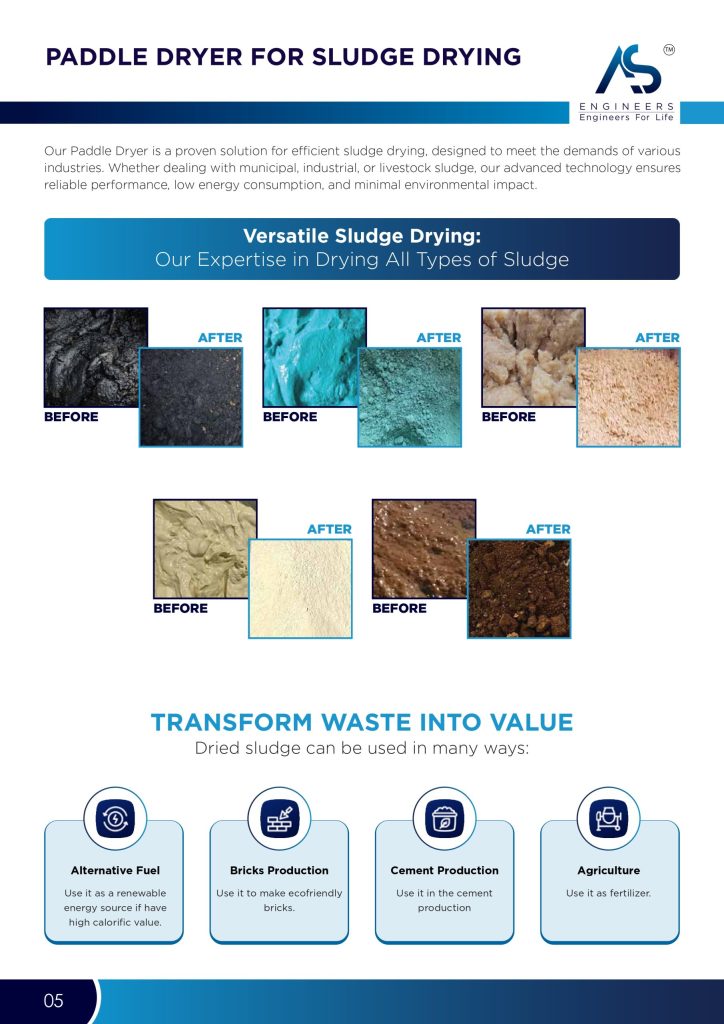
At AS Engineers, we understand the real-world challenges industries face with sludge management. That’s why we designed our paddle dryer to do more than just dry sludge—it transforms a messy, costly problem into a manageable, efficient process. Our paddle dryer uses indirect heating to gently remove moisture, reducing sludge volume, lowering disposal costs, and helping businesses meet environmental norms with ease. It’s a silent worker behind the scenes, making plants cleaner, safer, and more sustainable. Whether you run an ETP, STP, or industrial unit, our paddle dryer simplifies your sludge drying needs—reliably, efficiently, and with minimal human intervention.
The Sludge Digestion Process Explained
Stage 1: Hydrolysis and Acidification
Complex organic polymers including proteins, carbohydrates, and lipids undergo enzymatic breakdown into simpler molecular compounds. Acidogenic bacteria convert these intermediate products into organic acids, alcohols, and carbon dioxide. This initial phase typically requires 2-3 days and establishes optimal conditions for subsequent methanogenic activity.
Temperature control proves critical during acidification as excessive heat accelerates acid production beyond the system’s buffering capacity, potentially causing pH drops that inhibit methane-producing organisms.
Stage 2: Methanogenesis
Methanogenic archaea consume organic acids and alcohols, producing methane and carbon dioxide as primary end products. This phase requires strictly anaerobic conditions and typically accounts for 60-70% of the total digestion period.
Successful methanogenesis depends on maintaining proper carbon-to-nitrogen ratios (25:1 to 30:1), adequate alkalinity levels, and absence of inhibitory substances including heavy metals and certain organic compounds.
Stage 3: Stabilization and Pathogen Reduction
Extended retention times at elevated temperatures achieve significant pathogen destruction while stabilizing remaining organic matter. Properly operated digesters eliminate 99% of pathogenic bacteria, viruses, and parasites, producing Class A or Class B biosolids suitable for various beneficial applications.
Benefits of Sludge Digester Wastewater Treatment
Environmental Protection
Sludge digesters prevent groundwater contamination and surface water pollution by containing and treating hazardous waste materials. The controlled decomposition process eliminates offensive odors and reduces greenhouse gas emissions compared to landfill disposal or uncontrolled decomposition.
Modern digesters capture methane that would otherwise escape to the atmosphere, preventing emissions equivalent to 25 times the global warming potential of carbon dioxide.
Energy Production and Cost Savings
Biogas production from sludge digesters generates renewable energy that reduces facility operating costs. A typical 10-million-gallon-per-day treatment plant produces sufficient biogas to meet 50-75% of its electrical energy requirements.
Economic benefits include:
- Reduced electricity purchases from utility providers
- Lower natural gas consumption for facility heating
- Potential revenue from excess energy sales
- Decreased sludge disposal costs through volume reduction
- Federal and state incentives for renewable energy production
Resource Recovery
Digested biosolids contain valuable nutrients including nitrogen, phosphorus, and potassium that benefit agricultural applications. High-quality biosolids replace commercial fertilizers while improving soil structure and water retention capacity.
Properly processed biosolids provide slow-release nutrients that reduce fertilizer runoff and associated water quality impacts compared to synthetic alternatives.
Regulatory Compliance
Sludge digesters help facilities meet stringent federal and state regulations governing biosolids quality, pathogen reduction, and vector attraction reduction. The EPA’s Part 503 Rule establishes specific requirements that properly operated digesters readily achieve.
Compliant facilities avoid costly penalties and maintain operational permits required for continued wastewater treatment activities.
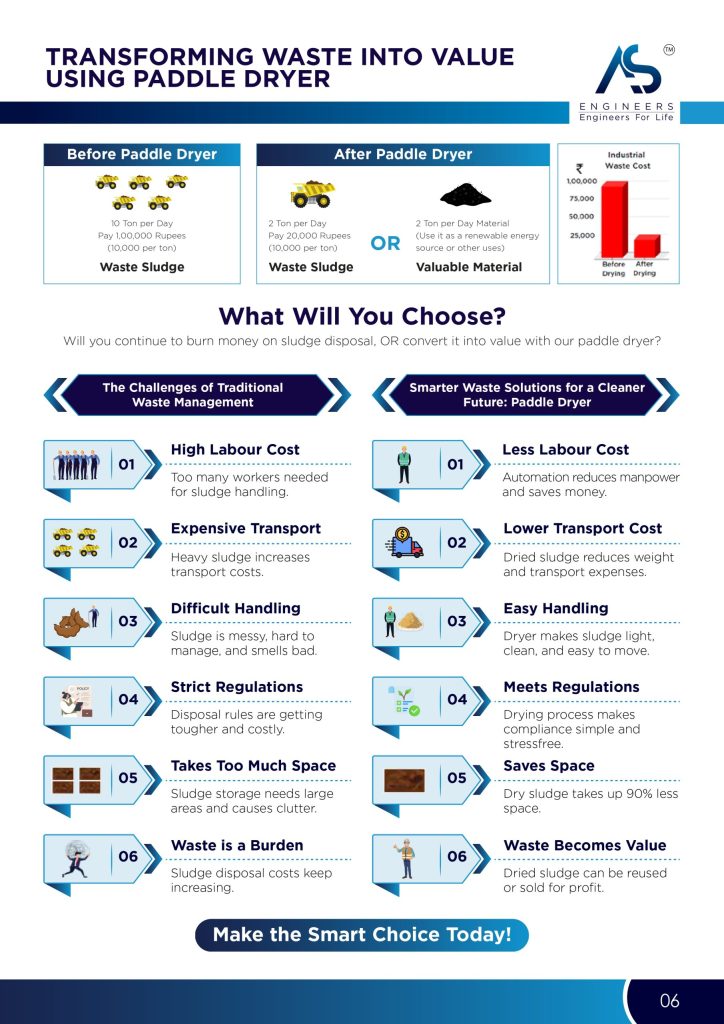
The paddle sludge dryer offers significant cost savings by reducing sludge volume and moisture content, which cuts down transportation and disposal expenses. Its low energy consumption, thanks to indirect heating and efficient heat transfer, minimizes operational costs. With low maintenance needs, continuous operation, and the ability to recover heat, it ensures long-term savings. Additionally, the dried sludge can be reused as fuel, further adding to the economic benefits and sustainability of your operations.
Design Considerations for Optimal Performance
Sizing and Capacity Planning
Proper digester sizing requires accurate assessment of sludge production rates, seasonal variations, and desired retention times. Undersized digesters compromise treatment efficiency and biogas production, while oversized systems increase capital costs without proportional benefits.
Design engineers typically size digesters for peak month sludge production with 20-25% safety factors to accommodate operational flexibility and future growth.
Temperature Control Systems
Maintaining optimal digestion temperatures requires sophisticated heating systems and insulation strategies. Steam, hot water, or direct biogas combustion systems provide process heating, while heat exchangers recover thermal energy from digester effluent.
Proper temperature control reduces digestion time, increases biogas production, and ensures reliable pathogen destruction across seasonal temperature variations.
Mixing and Agitation Equipment
Effective mixing prevents stratification, ensures uniform temperature distribution, and maintains intimate contact between microorganisms and organic substrates. Gas mixing systems utilize produced biogas for internal circulation, while mechanical mixers provide positive agitation control.
Inadequate mixing creates dead zones that reduce treatment efficiency and allow scum formation that interferes with gas collection systems.
Gas Collection and Processing
Comprehensive biogas collection systems maximize energy recovery while ensuring safety through proper ventilation and explosion prevention measures. Gas processing equipment removes hydrogen sulfide, moisture, and other impurities that damage energy generation equipment.
Advanced facilities incorporate gas storage systems that balance biogas production fluctuations with consistent energy demand patterns.
Common Challenges and Solutions
Process Upset Prevention
Sludge digesters require stable operating conditions to maintain healthy microbial populations. Sudden temperature changes, pH fluctuations, or toxic substance introduction can disrupt biological processes and require weeks for recovery.
Prevention strategies include:
- Comprehensive pretreatment to remove inhibitory substances
- Gradual temperature adjustments during seasonal transitions
- Regular monitoring of key process parameters
- Backup heating systems to prevent temperature losses
- Proper operator training for emergency response procedures
Foam Control
Excessive foam formation interferes with gas collection, reduces effective digester volume, and creates operational safety hazards. Foam typically results from high organic loading rates, improper mixing, or presence of surfactants in the feed sludge.
Effective foam control involves adjusting feed rates, improving mixing patterns, and applying chemical defoaming agents when necessary.
Maintenance Requirements
Regular maintenance ensures reliable digester operation and prevents costly equipment failures. Critical maintenance activities include gas system inspections, mixing equipment service, and heat exchanger cleaning.
Preventive maintenance programs reduce unplanned downtime and extend equipment service life while maintaining optimal treatment performance.
Future Trends in Sludge Digester Technology
Advanced Process Control
Automated control systems utilizing artificial intelligence and machine learning optimize digester performance through real-time parameter adjustment. These systems predict process upsets, optimize feeding schedules, and maximize biogas production while minimizing operator intervention.
Smart sensors provide continuous monitoring of critical parameters including pH, temperature, volatile fatty acids, and biogas composition.
Enhanced Resource Recovery
Emerging technologies recover additional valuable products from digester operations including struvite precipitation for phosphorus recovery, ammonia stripping for nitrogen capture, and carbon dioxide purification for industrial applications.
These advanced recovery systems transform wastewater treatment from waste disposal to resource production facilities.
Energy Optimization
Combined heat and power systems, fuel cells, and microturbines maximize energy utilization from biogas production. Grid-tie capabilities allow facilities to sell excess electricity while maintaining energy security through on-site generation.
Energy storage systems balance production and demand while providing backup power during utility outages.
Frequently Asked Questions
- How long does sludge digestion take in wastewater treatment?
Sludge digestion typically requires 15-30 days, depending on digester type, operating temperature, and organic loading rates. Thermophilic digesters achieve faster processing in 12-20 days while mesophilic systems require 20-30 days for complete stabilization. - What gases are produced during sludge digestion?
Anaerobic sludge digesters produce biogas containing 55-70% methane, 30-40% carbon dioxide, and trace amounts of hydrogen sulfide. This biogas provides renewable energy equivalent to 600-800 BTU per cubic foot. - How much biogas can a sludge digester produce?
A typical digester produces 12-18 cubic feet of biogas per pound of volatile solids destroyed. A 10-MGD treatment facility generates approximately 50,000-80,000 cubic feet of biogas daily, sufficient for substantial energy recovery applications. - Are sludge digesters safe to operate?
Properly designed and operated sludge digesters maintain excellent safety records through comprehensive gas monitoring, explosion prevention systems, and confined space entry procedures. Regular safety training and emergency response planning ensure worker protection. - What happens to digested sludge after treatment?
Digested biosolids undergo dewatering and further processing before being beneficially reused as soil amendments, fertilizers, or fuel supplements. Some facilities utilize advanced treatment, including composting or pelletization, for enhanced marketability. - What is a sludge digester and how does it work in wastewater treatment?
A sludge digester is a specialized reactor that facilitates the anaerobic digestion process, where microorganisms break down organic matter in sewage sludge in the absence of oxygen. This process transforms the sludge into biogas, primarily methane, which can be captured for energy production, and digestate, which can be used as a nutrient-rich fertilizer.
The digester creates an environment where conditions such as temperature, pH, and retention time are carefully controlled to optimize microbial activity and ensure effective sludge stabilization during the second stage of the digestion process, significantly reducing the volume of waste and improving overall wastewater management. - What are the main differences between anaerobic and aerobic sludge digestion?
The primary difference between anaerobic and aerobic sludge digestion lies in the absence of oxygen and the presence of oxygen during the process. Anaerobic digestion occurs without oxygen and involves microorganisms that thrive in such conditions, producing biogas as a byproduct.
In contrast, aerobic digestion requires oxygen and is facilitated by aerobic bacteria that oxidize organic matter. Anaerobic systems typically achieve higher energy recovery and significant volume reduction, while aerobic systems may be simpler to operate but generally produce more residual sludge and require continuous aeration. - What are the benefits of using anaerobic sludge digesters for sewage management?
Anaerobic sludge digesters offer numerous benefits for sewage management, including the generation of renewable energy in the form of biogas, a significant reduction in sludge volume through solids reduction, and improved pathogen destruction.
By efficiently breaking down organic material, these digesters minimize the amount of waste that must be transported and disposed of, lowering overall disposal costs. Additionally, the digestate produced can be repurposed as a valuable fertilizer, enhancing soil health while reducing reliance on chemical fertilizers. - What are the typical stages involved in the sludge digestion process?
The sludge digestion process typically involves four key stages: hydrolysis, the first stage of acidogenesis, acetogenesis, and methanogenesis. During hydrolysis, complex organic compounds are broken down into simpler molecules.
Acidogenic bacteria then convert these products into volatile fatty acids in the acidogenesis stage. Following this, acetogenesis turns these acids into acetate, hydrogen, and carbon dioxide. Finally, methanogenesis is where methanogenic microorganisms convert acetate and hydrogen into methane and carbon dioxide, completing the digestion process. - What factors influence the efficiency of sludge digesters in treating wastewater?
Several factors influence the efficiency of sludge digesters, including temperature, pH, organic loading rates, and the characteristics of the sludge being treated. Optimal temperatures typically range between 95-100°F for mesophilic and 130-135°F for thermophilic digestion systems.
Maintaining pH levels between 6.8 and 7.2 is crucial for microbial activity, while the organic loading rate must be controlled to avoid overloading the system. Additionally, sludge composition, including the concentration of volatile solids and the presence of toxic substances, can significantly affect digestion performance. - What types of byproducts are produced during sludge digestion?
During sludge digestion, the primary byproducts produced are biogas and digestate. Biogas, which is primarily composed of methane and carbon dioxide, can be utilized for energy production, reducing reliance on fossil fuels. Additionally, the digestate, or digested sludge, can include nutrient-rich food waste, and can be used as fertilizer or soil conditioner, providing valuable nutrients for agricultural applications while minimizing waste. - How does the sludge digester help in reducing volume and improving the disposal of sewage sludge?
Sludge digesters effectively reduce the volume of sewage sludge by breaking down organic matter through the anaerobic digestion process and converting it into biogas. This process can achieve a volume reduction of 50-60%, making the remaining digestate easier and less costly to manage. The stabilization of sludge through the anaerobic digestion process also minimizes odors and pathogens, making it safer for disposal or reuse in agricultural applications. - How is stabilized sludge disposed of after the digestion process?
Stabilized sludge, often referred to as digestate, is typically dewatered to reduce moisture content before disposal. Depending on local regulations and facility capabilities, it can be land-applied as fertilizer, used in composting, or further processed into pellets for energy recovery. Proper disposal methods help ensure that the nutrient-rich properties of the digestate are utilized effectively while minimizing environmental impacts. - What technologies are commonly used in modern sludge digester systems?
Modern sludge digester systems incorporate various technologies, such as advanced mixing systems, temperature control mechanisms, and biogas collection and processing equipment.
Additionally, pretreatment methods like thermal hydrolysis and ultrasonic destruction enhance digestion efficiency by breaking down complex organic materials before they enter the digester, offering improvements over conventional digestion. Automation and monitoring technologies allow for real-time adjustments to optimize performance and ensure compliance with regulatory standards. - Can sludge digesters be used for both municipal and industrial wastewater treatment?
Yes, sludge digesters can be effectively used for both municipal and industrial wastewater treatment. They provide a flexible solution for managing a wide variety of organic wastes, making them suitable for treating sewage sludge in municipal settings as well as high-strength waste generated by industries such as food processing, pharmaceuticals, and chemical manufacturing. - What is anaerobic digester sludge?
Anaerobic digester sludge refers to the organic matter that remains after the anaerobic digestion process has taken place. This sludge, often called digestate, is nutrient-rich and typically has a lower volume compared to the original sewage sludge. It is suitable for use as a soil amendment, or fertilizer, and as a soil conditioner, providing essential nutrients such as nitrogen and phosphorus to support plant growth. - What is the purpose of anaerobic sludge digestion?
The primary purpose of anaerobic sludge digestion is to stabilize organic waste, reduce its volume, and produce renewable energy in the form of biogas. This process of anaerobic sludge digestion also aids in pathogen destruction, improving the safety and quality of the resulting digestate, which can be repurposed for agricultural uses. Overall, anaerobic digestion contributes to more sustainable waste management practices. - How Do We Quantify Sludge?
Quantifying sludge involves measuring the volume and composition of sludge generated during wastewater treatment processes. Common methods include determining the solids concentration through laboratory analysis, often expressed in terms of total suspended solids (TSS) or volatile solids (VS). Accurate quantification is essential for designing treatment systems, optimizing operations, and ensuring compliance with regulatory requirements.
Conclusion
Sludge digester wastewater treatment transforms environmental challenges into valuable opportunities through efficient waste processing, renewable energy production, and resource recovery. Modern digester systems achieve remarkable results including 90% pathogen reduction, 50-60% volume reduction, and sufficient biogas production to meet substantial facility energy requirements.
Successful implementation requires careful attention to design principles, operational parameters, and maintenance requirements that ensure optimal performance and regulatory compliance. The integration of advanced control systems and emerging technologies continues expanding the benefits while reducing operational complexity.
Facilities investing in properly designed sludge digester wastewater treatment systems realize immediate operational benefits while contributing to sustainable waste management practices that protect public health and environmental quality. The combination of proven technology, economic advantages, and environmental stewardship makes sludge digesters essential components of modern wastewater treatment infrastructure.
Ready to optimize your facility’s sludge management strategy? Contact our team of wastewater treatment specialists to explore customized digester solutions that maximize efficiency, reduce costs, and enhance environmental performance for your specific operational requirements.

